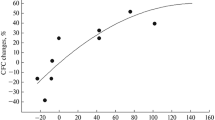Summary
Experiments were carried out on the innervated lung preparation of Rana esculenta in order to investigate the neuromuscular transmission.
-
1.
Acetylcholin, adrenaline and 5-hydroxytryptamine could be extracted from the lungs.
-
2.
Experiments with hyoscine and prostigmin demonstrate, that smooth muscle contraction due to nervous stimulation (0.2–1 Hz) is based mainly on a cholinergic mechanism.
-
3.
High doses of bretylium (10−4 g/ml) inhibit the relaxation induced by nervous stimulation (10 Hz). The β-receptorblocking agents propranolol, kö 592 (10−4 to 5×10−5 g/ml) inhibit the relaxation induced by nervous stimulation (10 Hz), 5-HT and adrenaline.
-
4.
Increased activities of C14-5-HT and in a less degree of C14-adrenaline were found in the outflow of perfused lung preparation during rhythmic stimulation of the nerve (10 Hz).
-
5.
Some antiserotonins which were found to inhibit the serotonin effect on the frog lung block the nervous stimulation but not the effect of adrenaline. TTX (5×10−7 g/ml) inhibits the 5-HT effect in a very slight degree.
-
6.
5-hydroxytryptamine seems to play a role as a physiologic transmitter in the frog lung in seasonal dependence.
Zusammenfassung
Versuche am Nerv-Lungenpräparat des Frosches (Rana esculenta) hatten zum Ziel, die Art der neuromuskulären Erregungsübertragung zu identifizieren.
-
1.
In Lungenextrakten konnte Acetylcholin, Adrenalin und 5-Hydroxytryptamin (5-HT, Serotonin) bestimmt werden.
-
2.
Eine nerval (0,2–1 Hz) ausgelöste Kontraktion der glatten Muskulatur ist im wesentlichen cholinergisch, wie Versuche mit Hyoscin und Prostigmin zeigen.
-
3.
Hohe Dosen Bretylium (10−4 g/ml) hemmen die durch Nervreizung (10 Hz) ausgelöste Erschlaffung. β-Receptorenblocker (Propranolol, Kö 592 10−4 bis 5 · 10−5 g/ml) hemmen die durch Nervreizung, 5-HT und Adrenalin ausgelöste Erschlaffung.
-
4.
Am Durchströmpräparat werden bei rhythmischer Reizung des Lungennerven (10 Hz) vor allem C14-markiertes 5-Hydroxytryptamin und in geringerem Maße markiertes Adrenalin vermehrt ausgeschwemmt.
-
5.
Einige der an der Froschlunge wirksam gefundenen Antiserotonine hemmen die indirekte Reizung, ohne die Adrenalinwirkung zu verhindern. Tetrodotoxin (5 · 10−7 g/ml) hemmt den Serotonineffekt nur gering.
-
6.
5-Hydroxytryptamin scheint in jahreszeitlicher Abhängigkeit als physiologischer Transmitter in der Froschlunge eine Rolle zu spielen.
Similar content being viewed by others
Literatur
Andén, N. E., u.T. Magnusson: Acta physiol. scand.69, 87–94 (1967).
Bouillon, D. J.: J. Physiol. (Lond.)189, 85–99 (1967).
—,E. Costa, andB. B. Brodie: Pharmacologist6, 196 (1964).
———: Int. J. Neuropharmacol.5, 293–298 (1966).
———: J. Pharmacol. exp. Ther.157, 126 (1967).
Brecht, K.: Pflügers Arch. ges. Physiol.246, 555 (1943).
—, u.D. Jeschke: Pflügers Arch. ges. Physiol.274, 385 (1962).
—, u.H. Kaumans: Z. Biol.1, 69 (1949).
Bülbring, E., andM. D. Gershon: J. Physiol. (Lond.)192, 823–846 (1967).
Burn, J. H., J. J. Dromey, andB. J. Large: Brit. J. Pharmacol.21, 96 (1963).
Campbell, G.: J. Physiol. (Lond.)185, 600–612 (1966).
Falck, B., J. Häggendal, andCh. Owman: Quart. J. exp. Physiol.48, 253 (1963).
Gaddum, J. H., andZ. P. Picarelli: Brit. J. Pharmacol.12, 323–328 (1957).
Gaupp, E.: Anatomie des Frosches, 2. Aufl. Braunschweig 1904.
Gershon, M. D.: J. Physiol. (Lond.)186, 4–5 P (1966).
Gertner, G. A., andA. Romano: Biochem. Pharmacol.8, 19–20 (1961).
Gillespie, J. S., andS. M. Kirpekar: J. Physiol. (Lond.)187, 51–68 (1966).
Groat, W. C. de, andR. L. Volle: J. Pharmacol. exp. Ther.154, 200 (1966).
Hertting, G., andJ. Axelrod: Nature (Lond.)192, 172–173 (1961).
Jeschke, D.: Dissertation, Tübingen 1962.
—, u.K. Brecht: Z. Biol.115, 55 (1965).
Kadatz, R.: Pflügers Arch. ges. Physiol.252, 1 1948 (1949/50).
Robertson, P. A.: J. Physiol. (Lond.)125, 37–38 P (1954).
Rosell, S., I. J. Kopin, andJ. Axelrod: Amer. J. Physiol.205, 317–321 (1963).
Schnizer, W., D. Krauss u.K. Brecht: Z. Biol. (im Druck).
Schümann, H. J.: Naunyn-Schmiedebergs Arch. exp. Path. Pharmak.209, 340 (1950).
Singh, J.: Arch. int. Pharmacodyn.146, 350 (1963).
Snyder, S. H., J. Axelrod, andM. Zweig: Biochem. Pharmacol.,14, 831–835 (1965).
Trendelenburg, U.: Brit. J. Pharmacol.11, 74–80 (1956a).
Vennsalu, A.: Acta physiol. scand.49, Suppl. 173 (1960).
Author information
Authors and Affiliations
Additional information
Mit Unterstützung der Deutschen Forschungsgemeinschaft.
Rights and permissions
About this article
Cite this article
Schnizer, W., Hoang, ND. & Brecht, K. Transmitter in der Froschlunge. Pflugers Arch. 304, 271–283 (1968). https://doi.org/10.1007/BF00592130
Received:
Issue Date:
DOI: https://doi.org/10.1007/BF00592130




